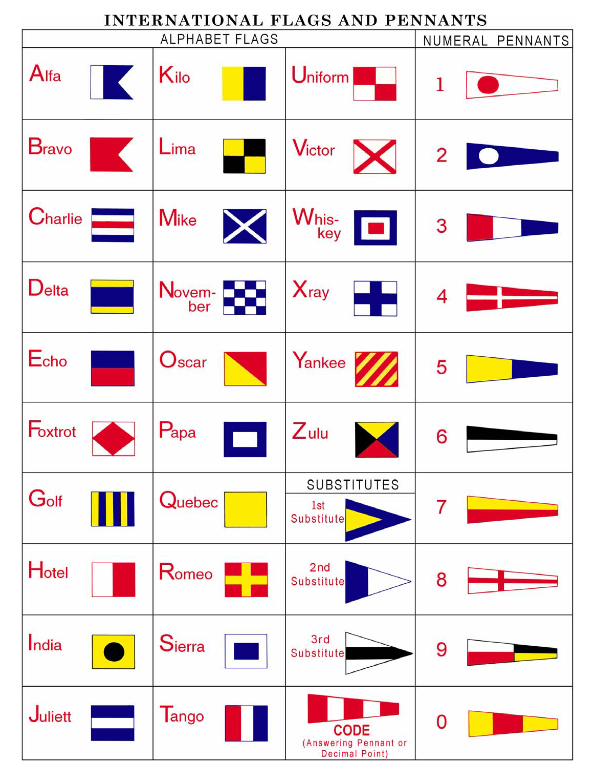Communications
International Code of Signals
The INTERCO: the international code of signals is an international marine publication which exists to adopt standard phrases and communications between vessels and is able to be used worldwide, irregardless of what language crewmembers speak. A current copy of this publication is available on the geospacial intelligence website. There is certain information in this publication which is intended to be memorized (flags and single flag meanings) but otherwise is intended to be kept on hand in the event that communications must be established. (wikipedia)

international signal flags
International Distress Signals: Everything related to distress is contained within chapter 4 of the INTERCO, which contains additional distress signals on top of the signals provided by the COLREGS. The distress content is to be committed to memory but is very simple to parse through in comparison to other publications. Of particular note within chapter 4 are the aviation distress signals, such as rocking the wings of the plane at a low altitude over the vessels bow to direct attention.
Publications
Notices to Mariners: Notices to Mariners are published both annually and monthly by the Department of Fisheries and Oceans here. The monthly versions of the publication just contain amendments to the annual version over the course of a year, so viewing the most recent monthly version will save the effort of having to make manual corrections to the publication. The publication is split into 7 parts; A for aids to navigation, B for pilotage services, C for marine communcations and traffic services, D for search and rescue, E for marine occurances and pollution, F for national defense and military notices, and lastly part G for general information which falls under no other subheading. Due to the nature of the content, section F is of particular note as much of the information contained within it is very irregular to the ordinary practice of seamanship and so it is a positive idea to familiarize with the content even just to make oneself aware of what sort of activities are covered within this section (ie. actions to be taken after fishing up a torpedo). Being a wheelhouse publication, it is important to familiarize with Notices to Mariners in the event that something onboard is encountered that can be looked up inside the publication; like mandatory or compulsory pilotage procedures when entering Canadian waters, which are covered under section B.
Radio Aids to Marine Navigation: the radio aids to marine navigation is a wheelhouse-ready publication available here, and is published annually (and updated monthly) by the Department of Fisheries and Oceans. The publication was formerly published in two editions, pacific and atlantic, but has since been merged into one edition covering all regions of canada. There are five parts within the publication; the foreward covering miscellaneous radio communication related info (such as icebreaking services), part 2 containing information about facilities (canals/lochs and MCTS offices), part 3 covering vessel traffic services, part 4 containing general information (radio distress/service and systems info), and lastly part 5 containing information related to the environment (such as ice reporting and weather forecasting). It is advisable to become familiar with the publication in order to speed up the process of looking up specific information contained within. This publication can be used to look up any radio related information (MCTS call-in-points, respective channels used to contact traffic services, weather report times, etc), particularily during the passage planning phase of a voyage.